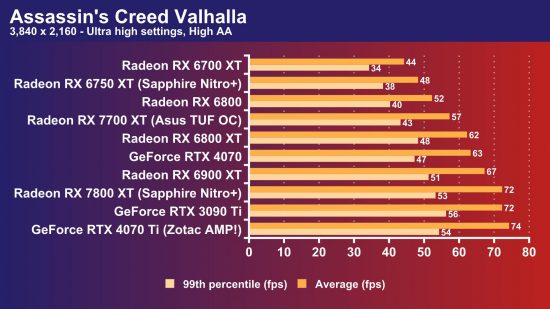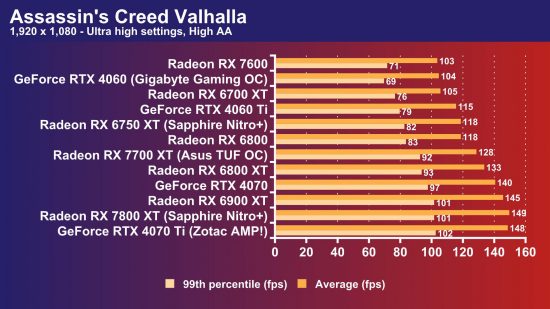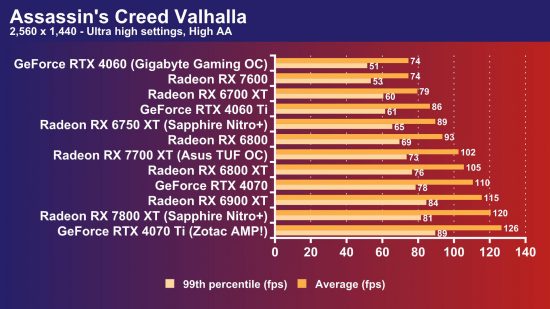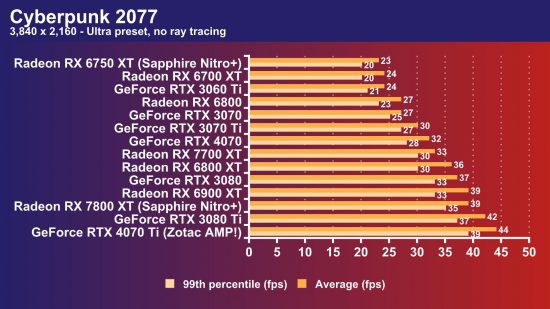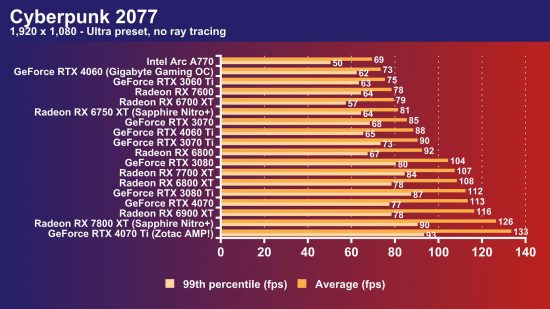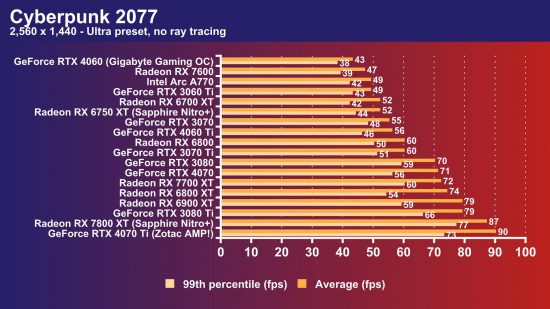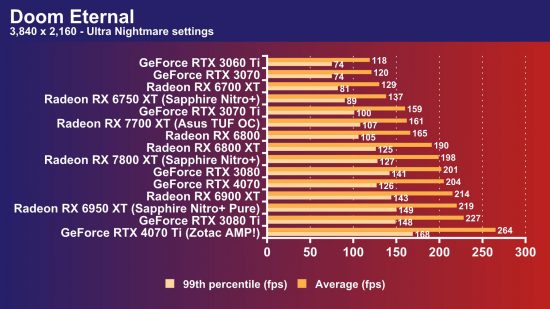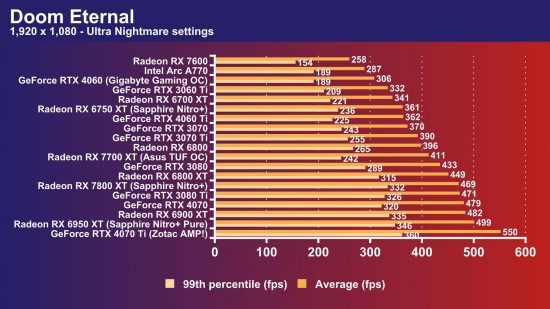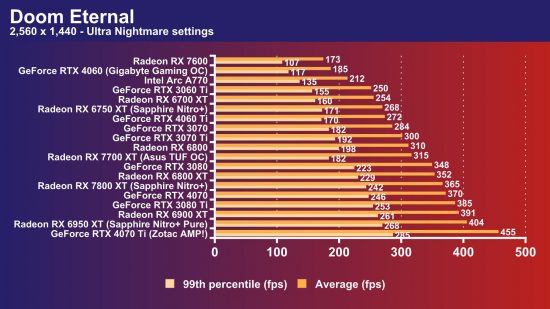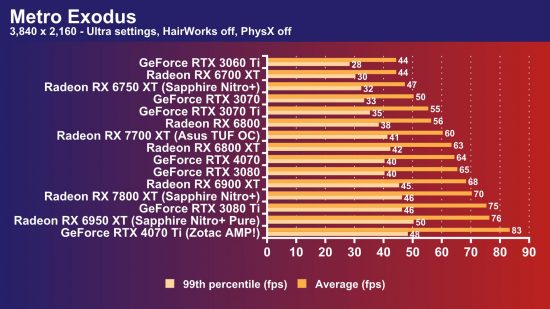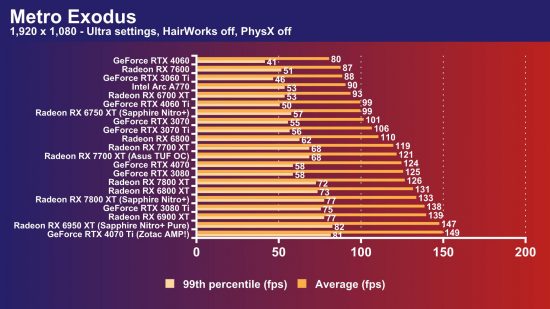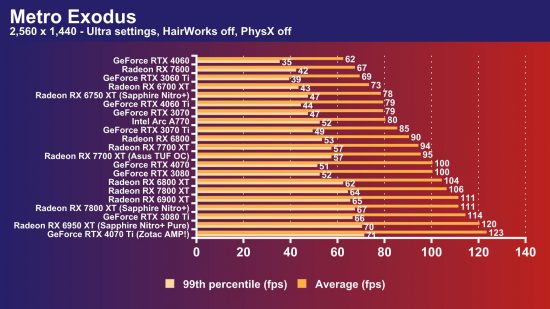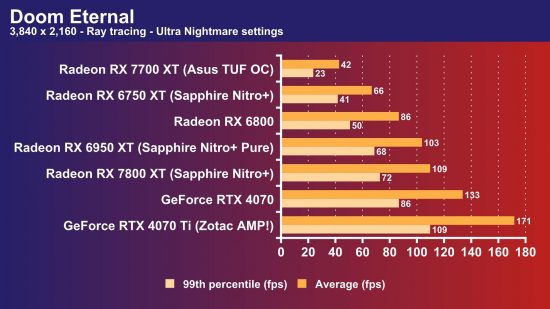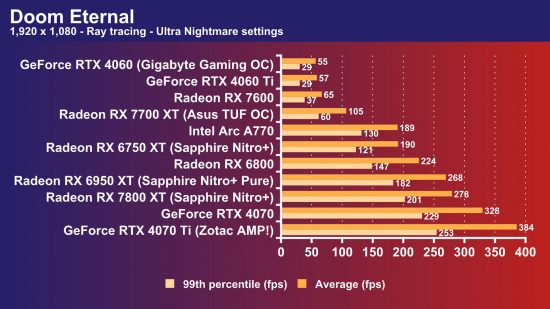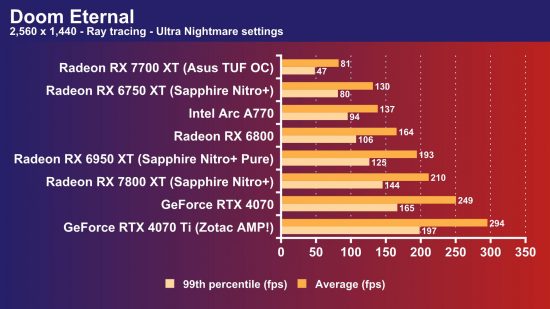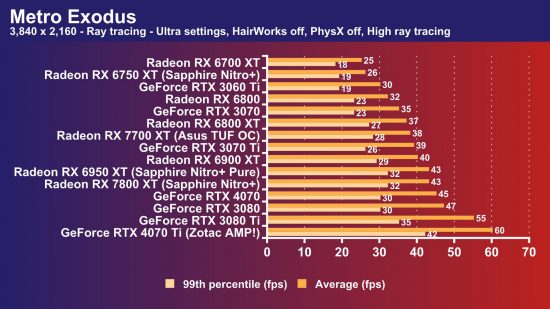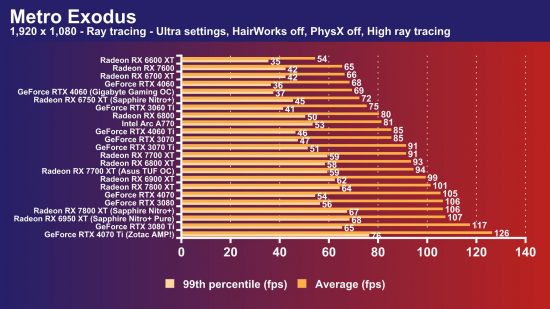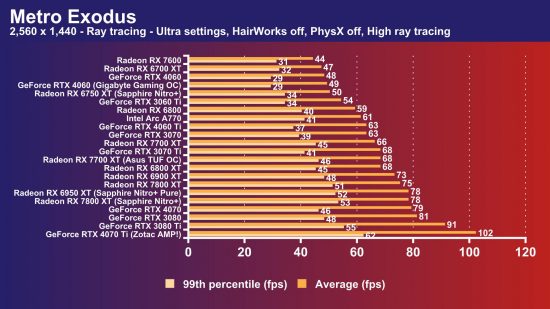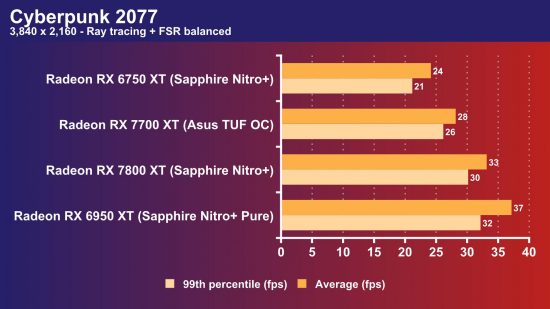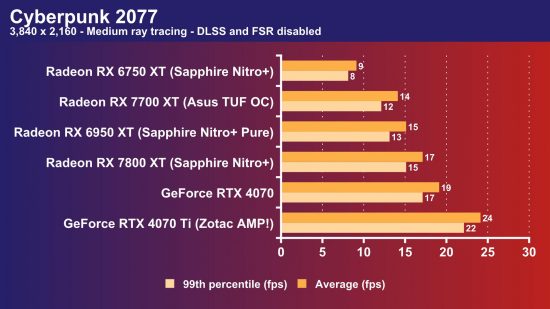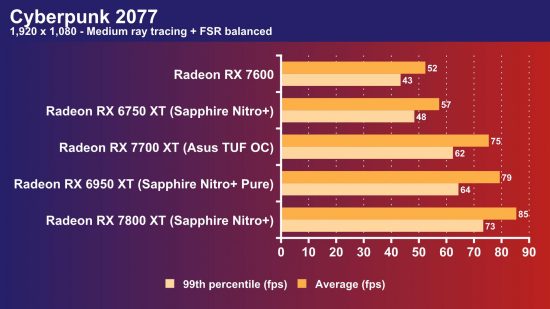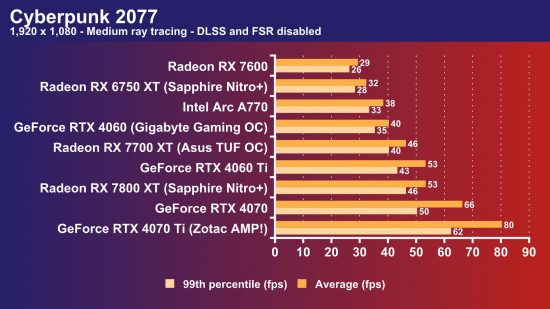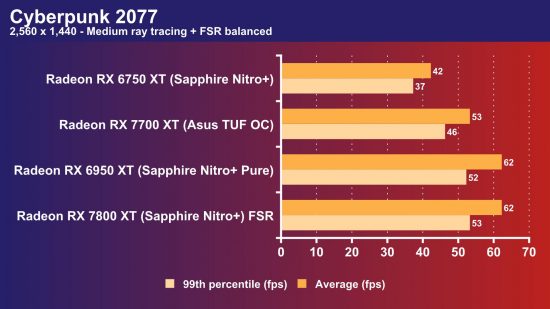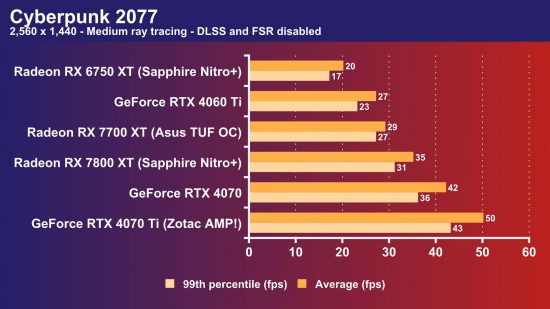Our Verdict
72%Fantastic rasterization performance compared to the RTX 4060 Ti, but it struggles with ray tracing and it's priced too close to the RX 7800 XT. The Radeon RX 7700 XT really needs to be $50 cheaper to be worth buying.
A lot of current graphics card prices look a bit like they’ve been randomly picked out of a hat at a party. Somebody, somewhere, thought the right price for the new AMD Radeon RX 7700 XT GPU was $449, but we’re struggling to work out the reasoning.
Not only is that a good $50 more than the GeForce RTX 4060 Ti 8GB that it’s aiming to beat, but it’s also only a stone’s throw from the price of the new Radeon RX 7800 XT, which launched at the same time. While AMD could have done with applying the same aggressive pricing policy to the RX 7700 XT that it did with the RX 7800 XT, though, the RX 7700 XT still has plenty going for it. Let’s take a look at what makes it tick.
At Custom PC, we’ve been reviewing the latest gaming GPUs since 2003, and we run a number of grueling GPU benchmarks in order to gauge performance. Our game tests include measuring the frame rate in Cyberpunk 2077, Doom Eternal, and Metro Exodus, all with and without ray tracing, and we also test with Assassin’s Creed Valhalla. For more information, see our How we test page.
AMD Radeon RX 7700 XT GPU
Like the new Radeon RX 7800 XT, the RX 7700 XT is based on AMD’s new Navi 32 chip. As with AMD’s top-end GPUs, such as the Radeon RX 7900 XTX, this GPU uses the AMD RDNA 3 architecture, and it’s also fabricated on TSMC’s 5nm process. Where it differs from the RX 7800 XT is in how many of its parts are enabled.
Six of the Navi 32 compute units have been disabled on the RX 7700 XT, giving you a total of 54. This gives you 3,456 stream processors, which is 384 fewer than the RX 7800 XT. This isn’t a massive reduction, which partly goes towards explaining the small difference in price between the two GPUs.
This means you also get 54 ray tracing cores, and 108 AI accelerators. The latter are AMD’s matrix processing cores, which are analogous to Nvidia’s Tensor cores, which it uses for DLSS, although AMD hasn’t yet provided any gaming features that use the AI accelerators. Meanwhile, the RX 7700 XT has a quoted game clock of 2171MHz, and a boost clock of 2544MHz.
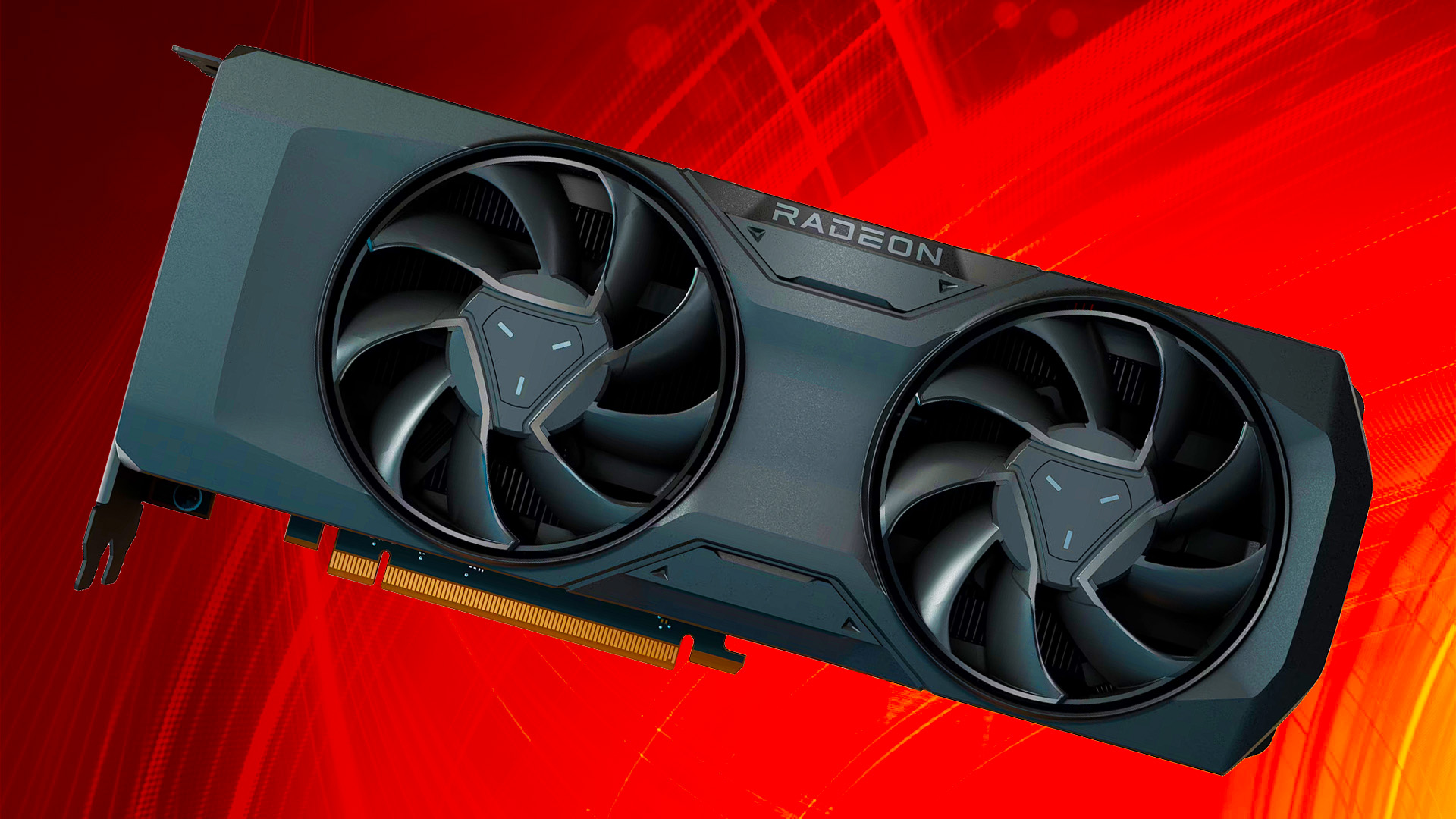
AMD Radeon RX 7700 XT memory
Rather than the GPU itself, the biggest difference between the RX 7700 XT and the RX 7800 XT is the memory configuration. It comes with 12GB of GDDR6 memory running at 2250MHz (18GHz effective), and it’s attached to a 192-bit memory interface. This gives you a total memory bandwidth of 432GB/s.
Comparatively, the RX 7800 XT has 16GB of memory effectively running at 19GHz, with a 256-bit interface, giving you a much fatter total bandwidth of 624GB/s. That said, there’s a similar leap between the RX 7700 XT and the GeForce RTX 4060 Ti 8GB below it. The latter has 4GB less memory, and a comparatively narrow bandwidth of just 288GB/s.
Nvidia makes up for this to a degree by equipping the RTX 4060 Ti with 32MB of L2 cache, helping to avoid cache misses so there isn’t as much strain on the memory bus. However, AMD is also playing the cache game, equipping the RX 7700 XT with 48MB of L3 Infinity Cache.
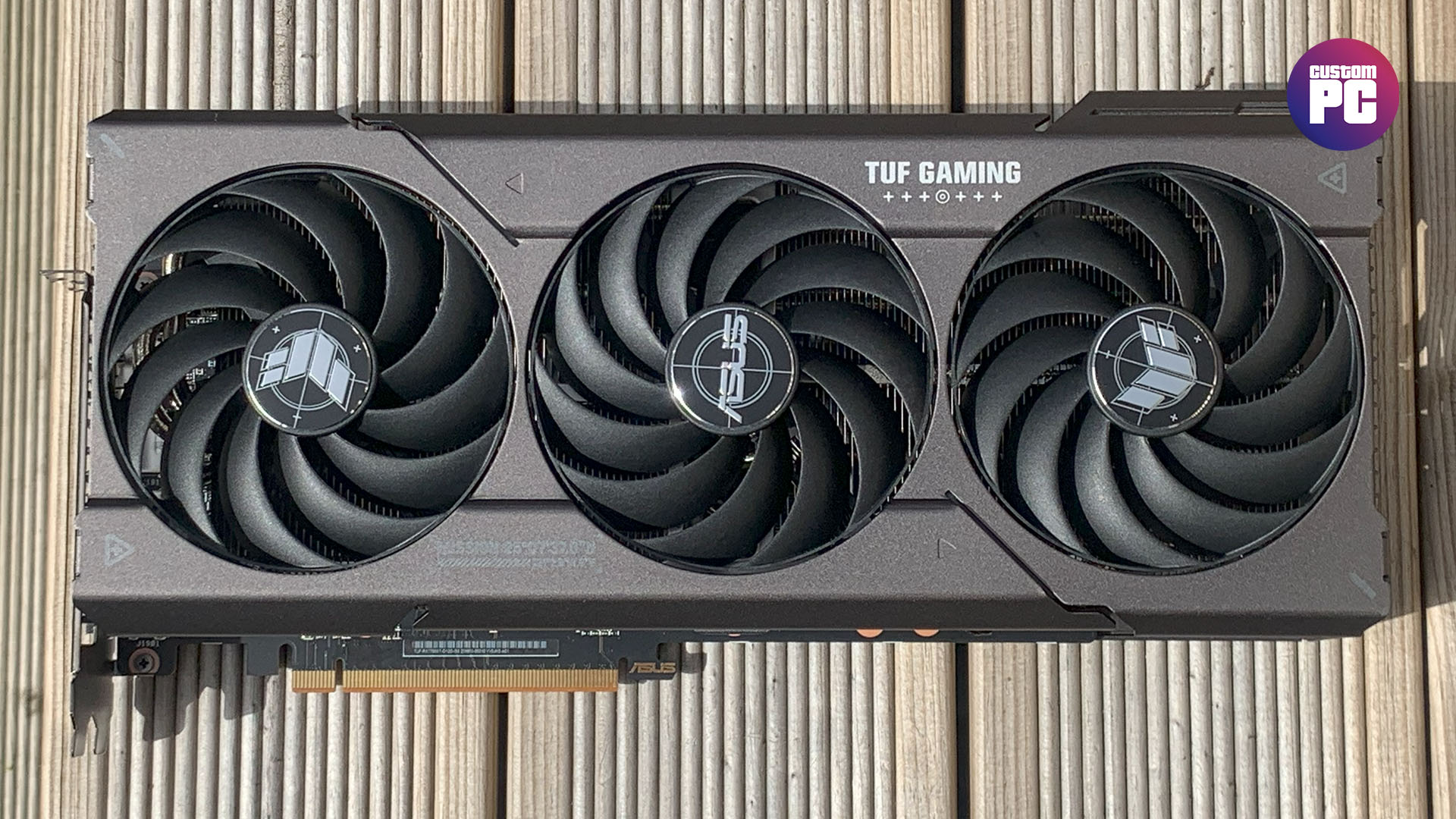
Interestingly, though, that’s half of the 96MB of L3 cache that came with the Radeon RX 6700 XT. Of course, AMD has changed its cache structure with RDNA 3, moving the cache out to chiplets that are separate from the main GPU die.
This adds latency, but AMD has countered that by significantly increasing the clock speed of the cache, while also optimizing it for better reuse of data than the cache in RDNA 2 GPUs. We’ll be interested to see how well the RX 7700 XT copes in VRAM-intensive benchmarks compared to its predecessor.
Asus TUF OC AMD Radeon RX 7700 XT
Our test sample for this review is an Asus TUF OC card, which adds an extra $50 to the MSRP of a standard, stock-speed RX 7700 XT card. This large graphics card has a small patch of RGB lighting on the right-hand edge corner, and it has a chunky metal backplate, along with two large sets of heatpipe-linked heatsink fins on either side of the cooler.
Asus has also taken the opportunity to increase the clock speed of the RX 7700 XT, with the GPU on the TUF OC card having a 2600MHz boost clock, an increase of 56MHz over the stock clock speed. That’s not an enormous overclock, but it should add a couple of extra frames per second to frame rates over a stock-speed card.
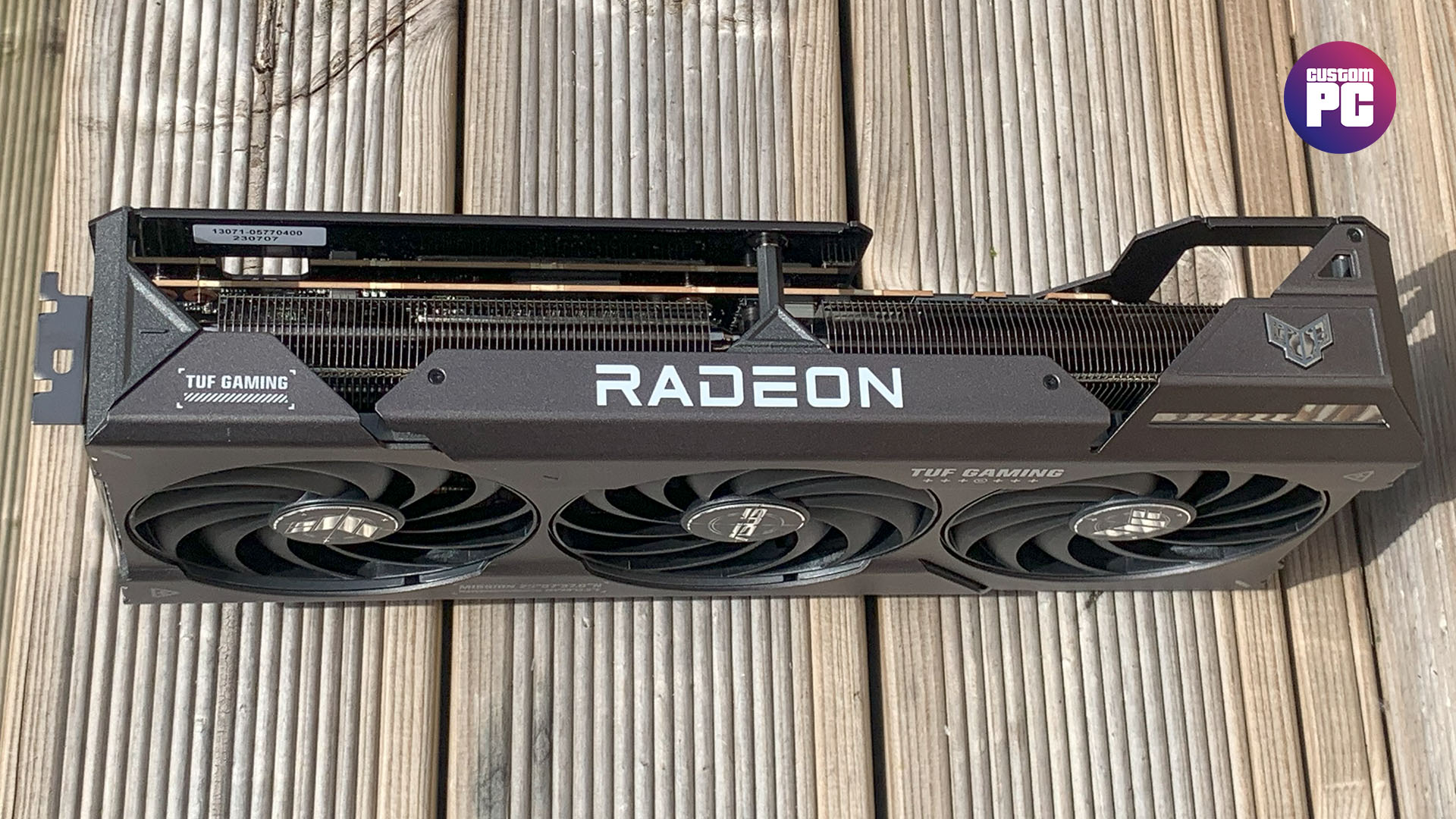
The cooler works well too, keeping the overclocked GPU running at around 57°C during benchmarks, with an 86°C hotspot. The GPU boosted to around 2763MHz during testing, showing that the cooler has plenty of power to cope with the overclocked GPU without throttling, and it runs quietly too.
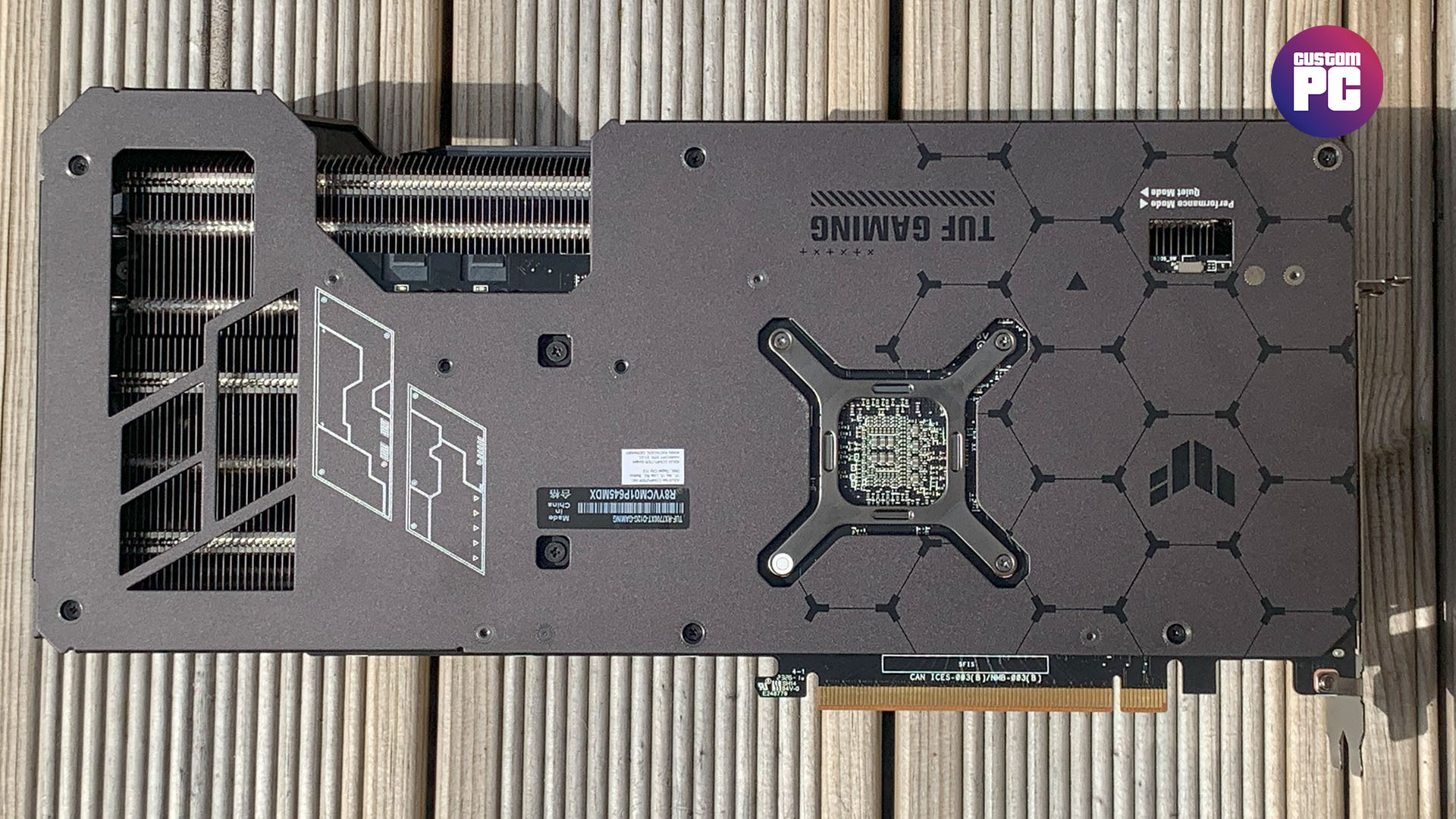
AMD Radeon RX 7700 XT frame rate
As with the Radeon RX 7800 XT, the RX 7700 XT really shines when it’s running games without ray tracing. At both 1080p and 2,560 x 1,440, this was a straight slam dunk for the RX 7700 XT against the RTX 4060 Ti. In every single test, the RX 7700 XT was well ahead of the Nvidia GPU.
The Radeon RX 7700 XT Assassin’s Creed Valhalla frame rate average of 128fps at 1080p is a good case in point, being 13fps ahead of the RTX 4060 Ti, and also 23fps in front of the Radeon RX 6700 XT. The RX 7700 XT also clocked up a great average of 102fps in this game at 1440p.
It didn’t quite hit our 60fps frame rate target at 4K, but it’s close at 57fps. The main problem for the RX 7700 XT here is that its bigger sibling, the RX 7800 XT can run this game at 72fps at 4K, and only costs $50 more.
The results were similar in our Radeon RX 7700 XT Cyberpunk frame rate test, where it averaged 107fps at 1080p and 72fps at 1440p with the Ultra preset – results that are both well ahead of the RTX 4060 Ti, which only averaged 56fps in this game at 2,560 x 1,440. You can’t run this game at 4K on the RX 7700 XT at these settings, but to be fair not even the GeForce RTX 4070 Ti can do that without some help from DLSS.
Likewise, the RX 7700 XT flattened the RTX 4060 Ti in our Radeon RX 7700 XT Doom Eternal frame rate test, achieving a fantastic average of 411fps at 1080p, compared with 362fps for the RTX 4060 Ti. Both results are good, of course, but the RX 7700 XT is clearly the more powerful GPU. Even 4K is achievable in this game with the RX 7700 XT, with an average of 161fps, and 99th percentile result of 107fps.
Finally, the Radeon RX 7700 XT Metro Exodus frame rate average of 119fps was again a good 20fps ahead of the RTX 4060 Ti at 1080p, and its 94fps average at 1440p is also a superb result for a GPU at this price. For this game, we also tried clocking our Asus test card down to stock speed to see what difference you gain from the overclock. The differences are small, with just a 1fps difference at 1440p, and a 2fps difference at 1080p.
AMD Radeon RX 7700 XT ray tracing
As we’ve come to expect from AMD over the last two GPU generations, where the RX 7700 XT falls down is ray tracing. We’ll get straight to the main disappointment, which is the Radeon RX 7700 XT Doom Eternal ray tracing frame rate average of 105fps at 1080p.
We were expecting the 12GB of memory and extra bandwidth of the RX 7700 XT to push its performance in this game to over 200fps. After all, the Radeon RX 6750 XT averaged 190fps in this test, and it has the same amount of memory and 192-bit bus.
This was an interesting game to play on the RX 7700 XT. Unlike the RTX 4060 Ti, which averaged a pitiful 57fps with a 29fps 99th percentile result), it was playable on the RX 7700 XT, but the 99th percentile dropped right down to 60fps, and you could tell the GPU was struggling. It was unplayable at 1440p on the RX 7700 XT, while the RX 6750 XT still averaged 130fps.
This could be down to poor driver optimization, or it may be that the RX 7700 XT needs more cache to enable it to spread its wings in these kinds of memory-intensive scenarios. Either way, it’s an area where the $499 RX 7800 XT is a clear winner, hitting a 210fps average at 1440p, compared with 81fps on the RX 7700 XT.
In other areas, the RX 7700 XT is more convincing at ray tracing. The Radeon RX 7700 XT Metro Exodus frame rate average of 94fps at 1080p is a case in point. That’s faster than the last-gen GeForce RTX 3070 Ti, as well as the RX 6800 XT, and it’s a good 9fps faster than the RTX 4060 Ti. The RX 7700 XT can also handle ray tracing in this game at 1440p, with its stock speed result sitting in between those of the GeForce RTX 3070 and RTX 3070 Ti.
As usual, though, Cyberpunk 2077 proved a tough task for the RX 7700 XT. The Radeon RX 7700 XT Cyberpunk 2077 ray tracing frame rate average of 46fps at 1080p is a good 7fps behind the RTX 4060 Ti, although it does at least beat the RTX 4060. Again, the RX 7800 XT is much more convincing here, with a 53fps average.
If you add FSR to the equation, you can get the RX 7700 XT to run Cyberpunk 2077 with the Medium ray tracing preset at a playable average of 75fps at 1080p, and 53fps at 1440p. The latter is an okay result, but again the RX 7800 XT’s 62fps average is much better.
The bigger problem for AMD in this game, though, is that while the RX 7700 XT can play this game at the Medium ray tracing preset with FSR enabled, the RTX 4060 Ti can get a helping hand with DLSS 3. This means you can even run Cyberpunk 2077 at the ultra ray tracing preset at 2,560 x 1,440, and it will average 103fps. It will even average 64fps in the new Overdrive mode with DLSS 3 enabled, which the RX 7700 XT couldn’t run in any way at all in our tests, dropping well below 10fps.
AMD Radeon RX 7700 XT power draw
The last part of the equation is the Radeon RX 7700 XT power consumption, and our test system drew 434W from the mains at load with the RX 7700 XT installed. That makes it more power-frugal than the Intel Arc A770 and the RX 6750 XT, but it’s still a high figure for the performance on offer. Comparatively, our system only drew 369W from the wall with the GeForce RTX 4070 running at full load.
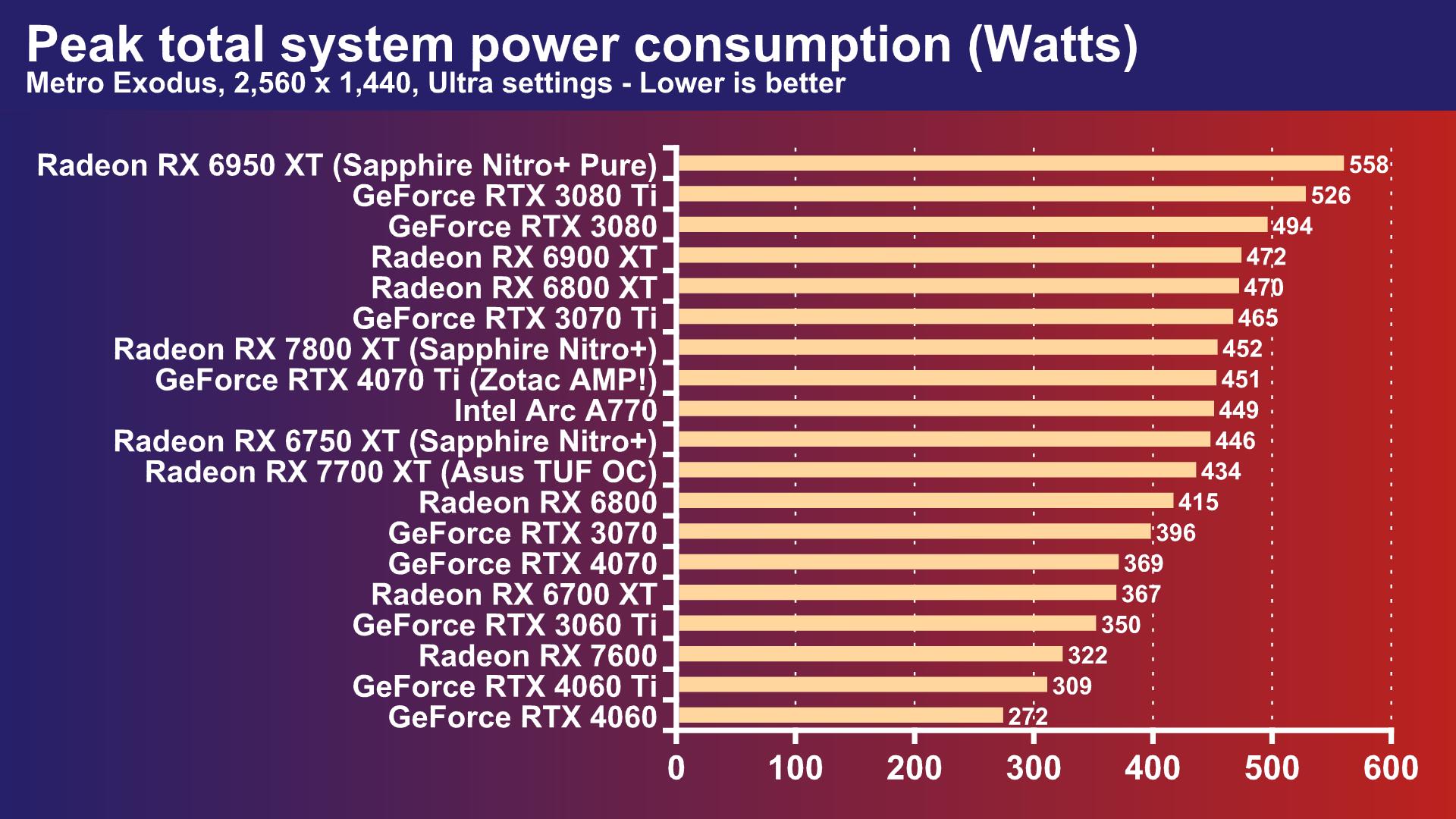
AMD Radeon RX 7700 XT pros and cons
Pros
- Awesome rasterization performance
- 12GB of memory
- Cheaper than RTX 4060 Ti 16GB
Cons
- Only $50 more for the superior RX 7800 XT
- Struggles with ray tracing
- No frame generation tech
AMD Radeon RX 7700 XT price
The AMD Radeon RX 7700 XT price is $449, which is slightly more expensive than the Nvidia RTX 4060 Ti 8GB but cheaper than the RTX 4060 Ti 16GB.
Price: $449
AMD Radeon RX 7700 XT specs
The AMD Radeon RX 7700 specs list is:
| GPU | Navi 32 |
| Compute units (CUs) | 54 |
| Stream processors | 3,456 |
| RT cores | 54 |
| AI Accelerators | 108 |
| ROPs | 48 |
| Game clock | 2171 MHz |
| Boost clock | 2544 MHz |
| L3 cache (2nd-gen Infinity Cache) | 48 MB |
| Memory | 12 GB GDDR6 |
| Memory bus | 192-bit |
| Memory clock | 2250 MHz (18 GHz effective) |
| Memory bandwidth | 432 GB/s |
| Interface | 16x PCIe 4 |
| Total board power | 245W |
| Recommended PSU | 700W |
| Power connectors | 2 x 8-pin |
AMD Radeon RX 7700 XT review conclusion
There’s a lot to like about the Radeon RX 7700 XT. It’s a better option than the RTX 4060 Ti 8GB in almost every respect, making it an ideal GPU for gaming at both 1080p and 1440p. The only benefit of the latter is DLSS 3 support in games such as Cyberpunk 2077, but the RX 7700 XT is clearly a more powerful GPU in every other scenario.
However, while the RX 7700 XT ray tracing performance is fine in old games such as Metro Exodus, where it also competes well with last-gen GPUs such as the RTX 3070 and 3070 Ti, it struggles in demanding games. Doom Eternal is a case in point – it has no trouble beating the RTX 4060 Ti 8GB in this test, but it would very probably struggle against the 16GB version of the card, and it’s well behind the RX 7800 XT in this test.
In fact, it’s the RX 7700 XT’s bigger sibling that’s its main problem. The RX 7800 XT only costs an extra $50 but has significantly more GPU headroom available. It has the memory and bandwidth to cope with VRAM-intensive game settings, and it can even open you up to 4K gaming in some scenarios. If you can stretch your budget by another $50, the RX 7800 XT offers much better bang per buck.
The current lack of AMD frame generation tech also hurts the RX 7700 – DLSS 3 support is the only reason you’d consider buying the RTX 4060 Ti over the RX 7700 XT, but it’s a good reason at the moment. You can run Cyberpunk 2077 on the RTX 4060 Ti with the ultra ray tracing preset at 103fps at 2,560 x 1,440 with DLSS 3 enabled, while the RX 7700 XT can only just about manage to play this game on the medium ray tracing preset at 1080p.
The crucial problem for the RX 7700 XT isn’t so much the GPU as the price. If it was $399, it would be a straight slam dunk over the RTX 4060 Ti, but at $449 it’s much less convincing. If AMD drops the price, and its future FSR frame generation tech works well, it will be worth a look, but at the moment the RX 7800 XT offers better value.

